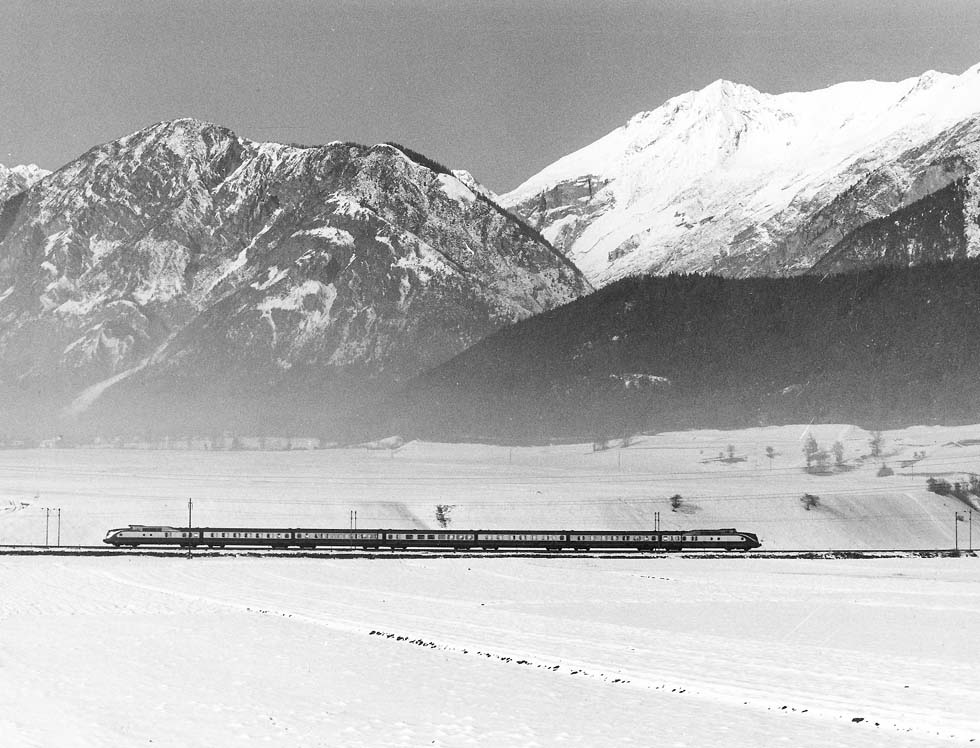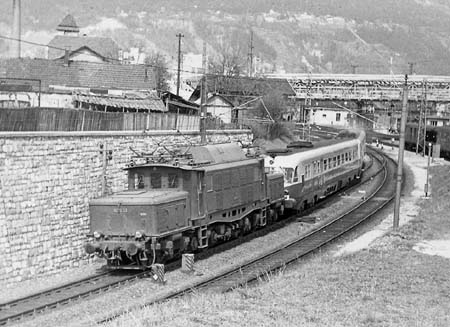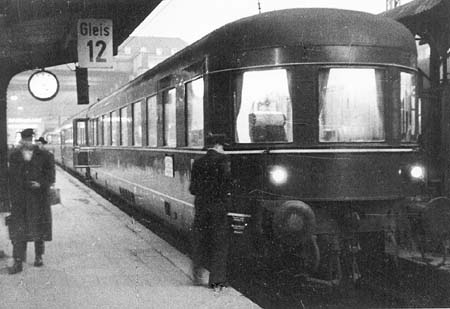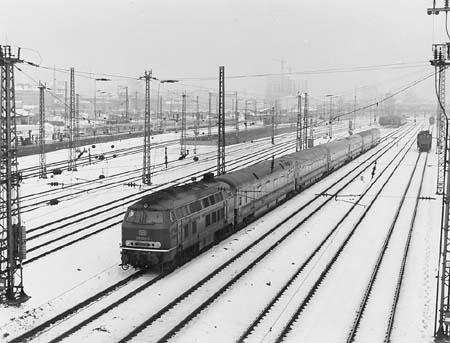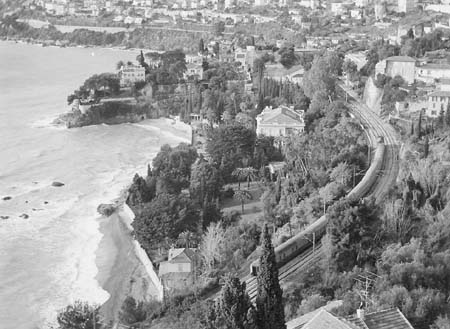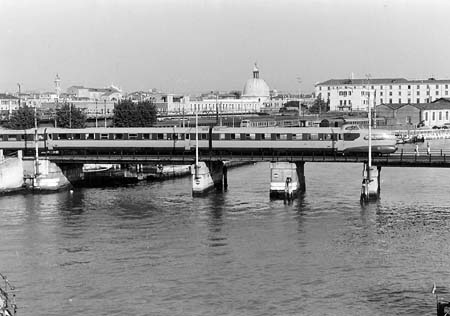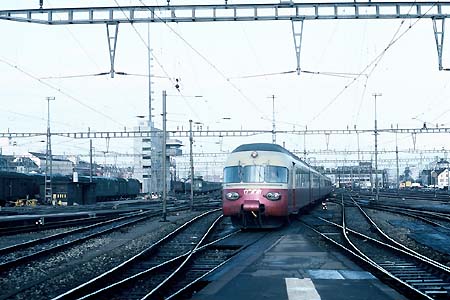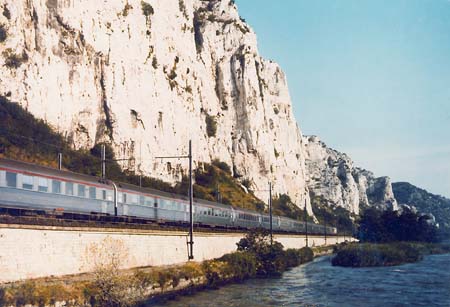|
T E E - T r a n s E u r o p E x p r e s s
Download this picture with 1500 pix, 300 dpi (579 KB)
DB prototype VT10 501 ‘Senator’, near Rendsburg (DB Museum)
The TEE were no high-speed trains, but they may be considered some sort of predecessors in Europe. High-speed development had started between the wars, in Germany pioneered by Franz Kruckenberg. “Der Fliegende Hamburger” of 1933 was the fastest train of the world, followed by other fast diesel railcars of the VT04, VT06 and after the war by VT08 series. High speed was pushed forward in Italy by electrified “direttissima” lines and by introducing the ETR200 electric multiple unit on the Milan - Naples run in 1939. Then France leaped ahead. Bugatti, after having built fast diesel railcars, planned streamlined steam-motor train sets, but World War II prevented the curious project. After the war, in the ‘50s, Europe’s most renowned train, the Mistral, on the Paris - Dijon section was the fastest train of the world. A French CC7100 and the BB9004 on tests south of Bordeaux established a sensational world speed record with 331km/h in 1955. On the other side of the border, the articulated German aluminum sleeping-car diesel train set “Komet” of 1953, created by Franz Kruckenberg and running for a short time Hamburg - Zurich, appeared like an “American” streamliner in Europe. Its brother was the 1st class day train “Senator”. DB however found out, that real luxury on rails never can be achieved due to the restricted space. Nevertheless on several railways in Europe in 1957 appeared the "Trans Europ Express", a new category of fast 1st class diesel multiple unit day trains. This great proposal was made in 1954 by Dr. H.J. den Hollander of Dutch railways. Unfortunately his idea of a multinational enterprise was prevented by national narrow-mindedness. 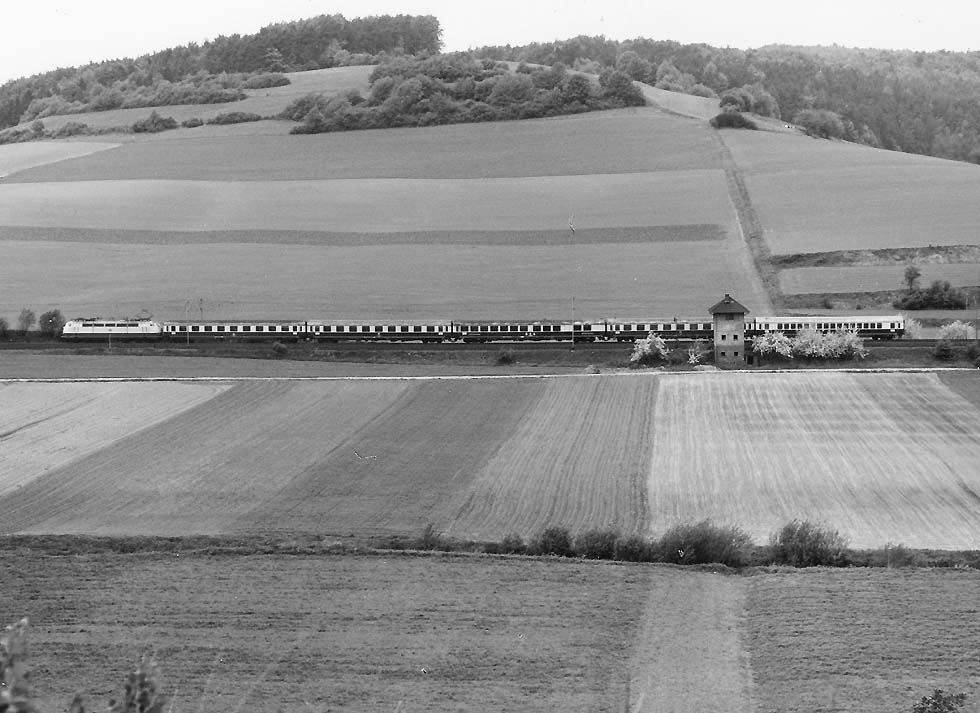 TEE Blauer Enzian Hamburg - Munich, DB prototype E03, connecting with TEE Mediolanum. Near Fulda c.1970 (WS)
Download this picture with 1500 pix, 300 dpi (417 KB)
Europe's most spectacular train was the "Settebello" of Italian railways FS. It had been introduced in 1953 on the Milan - Naples, then Milan - Rome run and it was a "lusso", much more exclusive than a TEE train. That ETR300 was a seven-car electric multiple unit, based on the ETR200 technology, but with a completely new concept, styled by architect Giulio Minoletti - with double-size compartments containing two sofas and four armchairs, of course a gourmet restaurant, an elegant bar, a boutique and, for the first time, round-end "Belvedere" observation lounges on both ends of the train. The drivers sat in an aircraft-like cockpit. The announced speed of 180 km/h was not yet attained by the two, from 1959 three ETR300 units, but only by its derivative ETR250 off 1960, four-car units without "lusso" extra-high fare. The ETR300, then classified as TEE trains, continued running Milan - Rome. The ETR250, coupled to the four-car upgraded ETR200 version, ran Milan - Naples as Frecchia di Vesuvio. In 1984 the proud Settebello was withdrawn from regular service. From 1963 also domestic 1st-class trains were classified as TEE and in 1964 SNCF and SNCB introduced locomotive-hauled TEE trains with new stainless "Inox" cars. In 1965 the famous Mistral Paris - Nice became a TEE and in 1969 it got new streamlined stainless cars. It included two diners, bar, boutique, barber shop and temporarily a cinema car was added. The stewardesses were clothed by Balmain. With introduction of the TGV Sud-Est Paris - Marseille in 1981 the end had come for the proud TEE Mistral and in 1984 also for the slightly similar TEE Cisalpin Paris - Milan. Passengers on the way to Nice were forced to change trains at Marseille. They could use the Italian TEE Ligure Marseille - Nice - Milan until finally in 1988 the TGV was extended to Nice.
TEE Milan – Munich, exceptionally with a CIWL-type blue diner, near Oberaudorf (WS)
In Germany the sensation was the blue/cream colored "Rheingold" off 1962, the first train with American style vista-domes, designed mainly under responsibility by engineer Dr. Mielich. It replaced the blue Rheingold, which had been introduced in 1951. Later the new Rheingold was classified as TEE train, now painted red/cream. In 1976 the vista-domes were sold, the Rheingold lost its glamour and in 1987 it was closed down. Then only SBB offered 1st class observation cars, but they were sold in 2005. Finally the restriction of TEE trains to 1st class was no longer up to date. Many TEEs were uneconomic, like also the German 1st class Intercity (IC) trains. The government was no longer willing to subsidize them at taxpayers’ expense. IC trains were opened to 2nd class and TEEs towards 1987 were replaced by equally nice Eurocity (EC) trains with 1st and 2nd class, now generally hauled by electric locomotives of the several railway administrations. Later EC trains disappeared more and more, facing the competition by low-fare air services. Swiss diesel TEE units had been sent to Canada, German VT115, a Settebello and a Swiss electric unit were prepared for tourist trips and French stainless TEE coaches were sold to Cuba. Formations TEE Mediolanum Munich - Milan, temporarily DB VT11.5 diesel hydraulic multiple unit, DB Zp e.g. 1972:
ETR300 Naples - Milan from 1953, later "Settebello" Rome - Milan, de-Luxe electric multiple unit 3kVdc, distributed power, articulated cars 1+2, 3+4+5, 6+7:
TEE Le Mistral Formation 1969 - 1981:
Colors : SNCF cars stainless, red ribbon, CC6500 silver/red, BB25000 turquoise. Rheingold-Express Hoek van Holland - Rome (not yet a TEE), arrival Rome, summer 1957: E428, 2 coaches FS, 2 vans FS, 1 coach SBB Berne - Rome, 1 sleeper CIWL type P and 1 coach SBB Geneva - Rome, 2 coaches SBB and 1 sleeper CIWL type P Zurich - Rome, 1 coach FS Dunkerque - Rome, 1 coach SNCB Brussels - Rome, 1 1st class SBB Basle(?) - Rome, 1 1st class DB Hoek - Rome. Colors: E428 khaki, FS cars brown/khaki, SBB dark-green, CIWL stainless, SNCB dark-green/light-turquoise, DB blue. TEE Rheingold Hoek van Holland - Geneva, by DB, formation according to DB Zp 1972:
Traction: DB 103 replaced 112; NS series 1100, 1200 or 1300; SBB Re 4/4. Colors: dark-red/cream (initially dark-blue/cream), NS locomotives dark-blue. Literature Maurice Mertens: TEE - Trans Europ Express. DVD Trans-Europ-Express by Xyania Internet Verlag 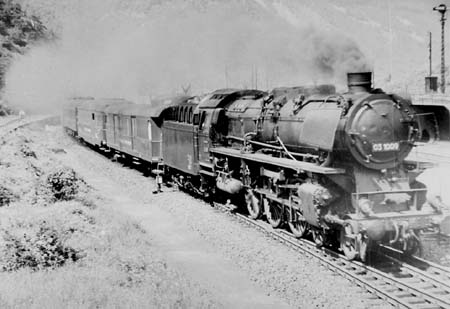 Rheingold Hoek - Basle/ - Munich - Innsbruck, Pacific 03.10, Bingerbrueck 1953 (Kurt Soelch)
Rheingold Hoek - Basle/ - Munich - Innsbruck, Pacific 03.10, Bingerbrueck 1953 (Kurt Soelch)
Lufthansa Airport Express Frankfurt – Dusseldorf, DB class 403/404, initially built for Intercity traffic, passing Burg Rheinstein in 1991 (WS) 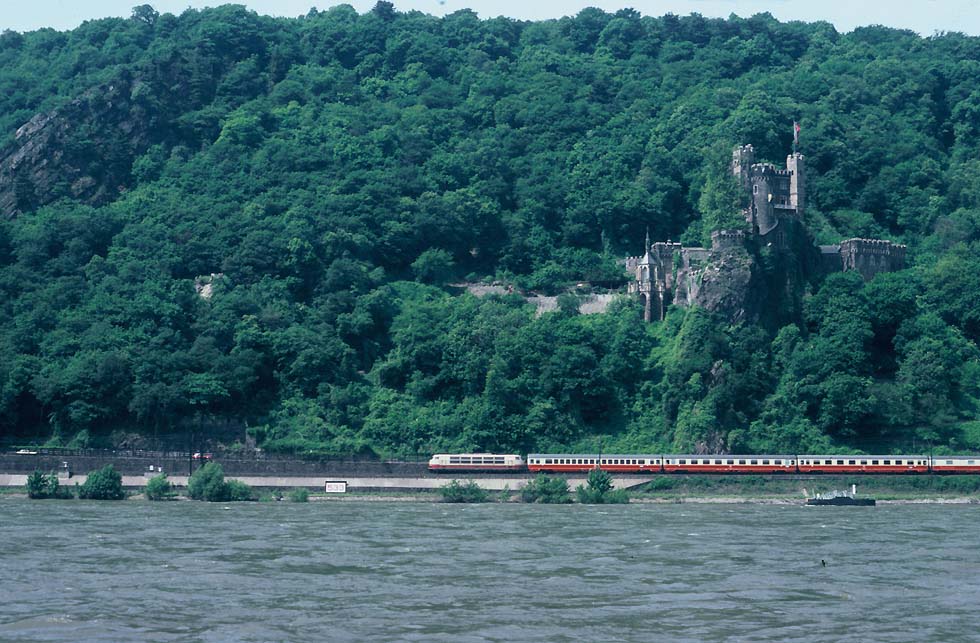 TEE Rheingold Amsterdam - Chiasso/- Chur, class 103, Rheinstein 1983 (Kyriaki Soelch)
Download this picture with 1500 pix, 300 dpi (588 KB)
|


